Unit 6. Automotive Components
Section A. Interior Components of a Car
I. Read the text “Automobile Work” and say what systems and working units are necessary for a good performance of a car.
Automobile Work
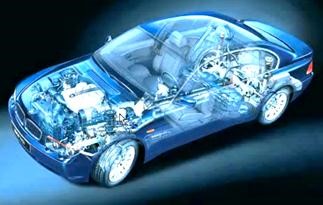
An automobile is composed of many different working units and parts. To provide the energy to make it move a car has an engine which in turn needs electric current, petrol and air. The engine also needs cooling so it does not become too hot and oil to lubricate the baring surfaces. There is the transmission system of a clutch, gearbox, propeller (cardan) shaft and axles which transmits power from the engine to wheels to move the car along the road. The steering mechanism is needed to guide the car in the right direction, brakes – to slow it down and stop it, and suspensions – to smooth out most of bumps and jolts.
Automobiles are trackless, self-propelled vehicles for land transportation of people or goods, or for moving materials. There are three main types of automobiles: passenger cars, buses and trucks. The automobile consists of the following components: a) the engine; b) the framework; c) the mechanism that transmits the power-engine to the wheels; d) the body.
An automobile, powered by a petrol engine, begins to operate when the driver turns a flywheel connected to the engine crankshaft. As the crankshaft revolves, a mixture of fuel and air is drawn from a carburetor into the engine cylinders. The ignition system provides the electric sparks that ignite this mixture. The resultant explosions of the mixture turn the crankshaft, and the engine starts moving.
Cooling, electrical, ignition and lubrication systems are of great importance for the good performance of a car. The lights, radio and heater add to the comfort and convenience of the car. The indicating devices keep the driver informed as to the engine temperature, oil pressure, amount of fuel, and battery charging rate.
Brakes are of drum, and disk types. The steering system consists of a manually operated steering wheel, which is connected by a steering column to the steering gear from which linkages run to the front wheels. It is difficult to turn the steering wheel, and special hydraulic power mechanisms are used to lessen this effort. Suitable springing are used against shocks. These are leaf springs, coil springs, torsion bars and air suspensions.
Notes:
current, n.–ток
to lubricate –смазывать
clutch, n.–сцепление
gearbox, n.-коробка передач
steering, n.-рулевое управление
suspension, n.–подвеска
bump, n.–столкновение
jolt, n.–удар
flywheel, n.–маховое колесо
crankshaft, n.- коленчатый вал
springing, n. – рессоры
charging rate, n.–скорость заряда аккумулятора
ignition system, n.-система зажигания
baring surfaces, n.–трущиеся поверхности
II. Answer the questions:
- What components does the automobile consist of?
- When does the engine start moving?
- What systems are of great importance for the good performance of a car?
- What do the indicating devices do?
- What can you say about the steering system?
III. Memorize the terms describing interior components of a car.
- steering wheel- рулевое колесо
- windscreen wipers - стеклоочиститель
- distributor - распределитель зажигания
- spark plug - свеча зажигания
- coil - катушка зажигания
- air filter - воздушный фильтр
- engine - двигатель
- fan - вентилятор
- battery - аккумуляторная батарея
- headlight - передние фары
- dynamo/alternator - генератор переменного тока
- side light/indicator light - указатель поворота
- steering box - рулевой механизм
- front suspension - передняя подвеска
- drum brake - колодочный тормозной механизм
- starter motor - стартер
- gearbox - коробка передач
- brake pedal - педаль тормоза
- clutch pedal - педаль сцепления
- gear stick lever - рычаг переключения передач
- propeller/cardan shaft - карданная передача
- universal joint - карданный шарнир
- shock absorber - амортизатор
- rear spring - задняя рессора
- petrol tank - бензобак
- filler cap - крышка топливного бака
- rear lights - задние фары
- rear axle - задняя ось
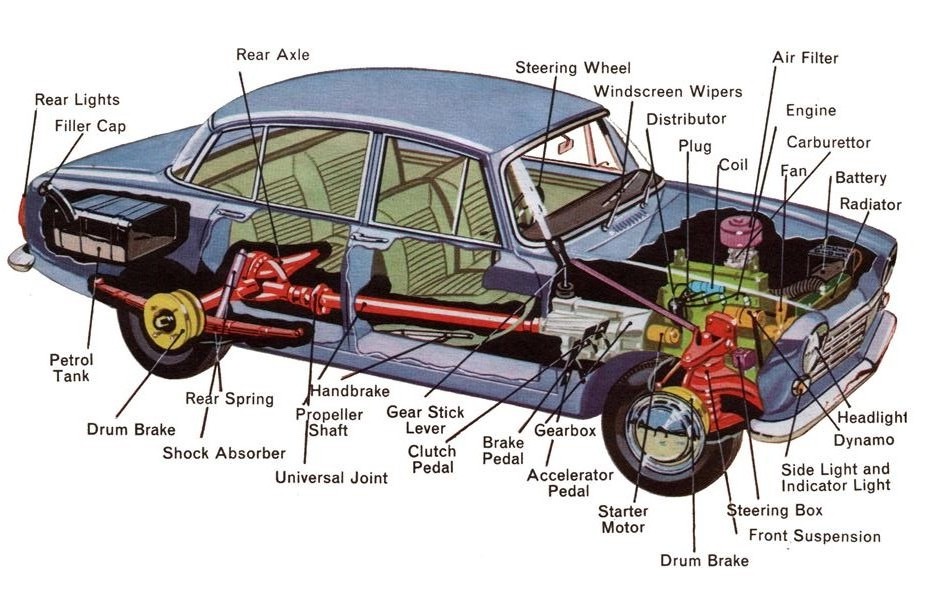
IV. Read the text “Car Instruments” and say what role car instruments play.
Car Instruments
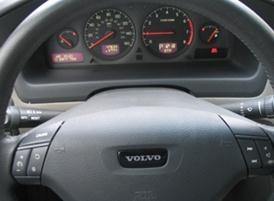
In order to be able to operate the vehicle safely, a driver must know the functions and locations of all the interior mechanisms of the car. The instrument panel contains gauges which include the following:
- a speedometer, which indicates speed in both miles and kilometers per hour;
- a tachometer, which indicates rotations in the engine in revolutions per minute(RPMs);
- an odometer, which indicates the total number of miles your car has been driven since it was manufactured;
- a fuel gauge, which shows the fuel level in your car's fuel tank;
- an oil gauge, which shows the oil level;
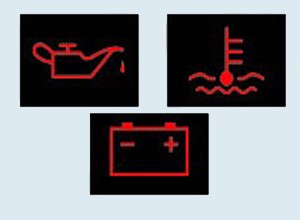
Warning lights are provided on the car's instrument panel. They light up in case of a serious problem.
There are three kinds of warning lights:
- Oil Pressure Warning Light
- Temperature Warning Light
- Battery Low Warning Light
An Oil Pressure Warning Light: this light goes on when the engine oil is not circulating at the required pressure. Some vehicles have an oil pressure gauge that reads LOW when the engine's oil pressure is too low. If you see an oil pressure warning while driving, STOP immediately at a safe place and turn off the engine.
A Battery Low Warning Light: when this light goes on or the battery gauge reads LOW, this means that the battery power is running out.
Notes:
gauge, n.–измерительный прибор
rotation, n.–вращение RPMs, n.–обороты в минуту
odometer, n. – одометр
total number, n. – общее количество
fuel gauge, n.–измеритель горючего
oil gauge, n. – масляной манометр
warning light, n. – лампа аварийной сигнализации
oil pressure, n. – давление масла required, adj.–требуемый
light up, v. – загораться LOW, adj.–низкий уровень
V. Read the text about two types of engines and compare them.
All motor vehicles have engines. The two most common types of engines for land vehicles are the petrol and the diesel engines. Petrol engines are usually lighter and smaller than diesel engines. Petrol engines are also less noisy than diesel engines. They usually go faster. On the other hand, diesel engines use less fuel and last longer than petrol engines. This is why larger vehicles such as trucks and trains use them. They are also safer than petrol engines, because there is less danger of fire.
All petrol engines have spark plugs and diesel engines do not have spark plugs. They have fuel injectors.
According to the engine cycle and configuration all internal combustion engines are divided into two stroke engines and four stroke engines.
For a four-stroke engine key parts of the engine include the crankshaft, one or two camshafts and valves. All four-stroke engines have an oil sump.
For a two-stroke engine there is an exhaust outlet and fuel inlet instead of a valve mechanism. They don’t use an oil sump because they have oil in the fuel.
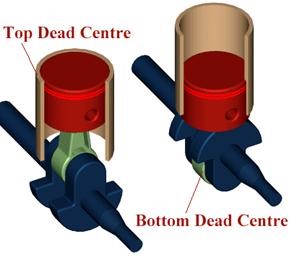
In both types of engines there are one or more cylinders and for each cylinder there is a spark plug, a piston and a crank. The activities that take place in the engine cylinder can be divided into four stages, which are called strokes. The four strokes are: intake, compression, power and exhaust. "Stroke" refers to the piston movement. The upper limit of piston movement is called top dead center, TDC. The lower limit of piston movement is called bottom dead center, BDC. A stroke constitutes piston movement from TDC to BDC or from BDC to TDC. In other words, the piston completes a stroke each time it changes the direction of motion.
Notes:
spark plug, n.–свеча зажиганияexhaust outlet, n. – выпуск
fuel injector, n.-топливная форсункаfuel inlet, n. – всасывание
two-stroke engine, n. – двухтактный двигатель
four-stroke engine, n. – четырёхтактный двигатель
oil sump, n. - масляный поддон valve, n.–клапан
crankshaft, n. – коленчатый вал piston, n. – поршень
compression stroke, n. – такт сжатия
combustion stroke, n. – рабочий ход
exhaust stroke, n.–такт выпуска
induction stroke, n. – ход (такт) впуска
top dead center, n.–верхняя мёртвая точка
bottom dead centre, n.–нижняя мёртвая точка
Section B. Car Operating Systems
I. Read the text “Fuel System” and explain the fuel system operation.
Fuel System
In addition to the engine itself there are four separate mechanisms which are used to feed the engine. These mechanisms are the fuel system, the lubrication system, the electrical system and the cooling system. The ignition system as a part of the electrical system is used to start the car.
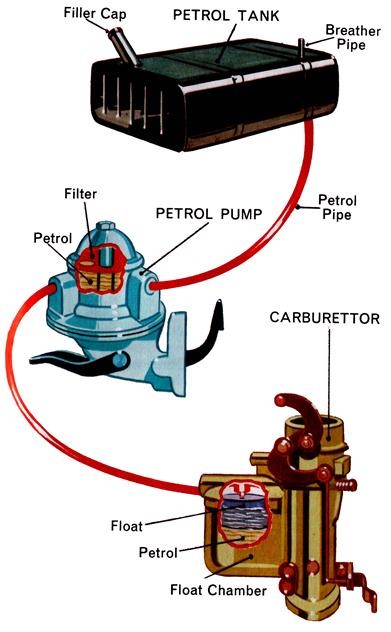
The fuel system consists of a tank, a fuel pipe, a pump and a carburetor.
The fuel is stored in a fuel tank. The fuel tank is connected to a fuel pipe. The fuel pipe carries fuel to the fuel pump. This pump can be either mechanic or electric in operation. Electric pumps are situated near the tank but a mechanic pump is located near the engine because it is driven by the camshaft.
The fuel pump is connected to the carburetor. There the fuel is mixed with air. The optimum ratio of air to petrol in the fuel mixture is 15 parts of air to 1 part of petrol.
The fuel and air are compressed by the piston and they are drawn into the engine.
In the engine the fuel and air are burnt and produce power.
Notes:
fuel, n. – топливо
fuel pipe, n.–топливопровод
pump, n.–насос
fuel tank, n.– топливный бак
camshaft, n.–кулачковый вал
petrol, n.–бензин
ratio, n.–пропорция, соотношение
piston, n.– поршень
II. Read about the lubrication system and describe it using the diagram.
The lubrication system delivers oil to the moving parts of the engine. As the oil circulates through passages in the engine it spreads a film on the parts. Lubrication reduces friction and so minimizes engine wear. The oil also helps to cool the engine. Oil is stored in a pan under the engine. A pump circulates oil from the pan through a filter and then through lines to the engine. This filter prevents impurities from entering the engine.
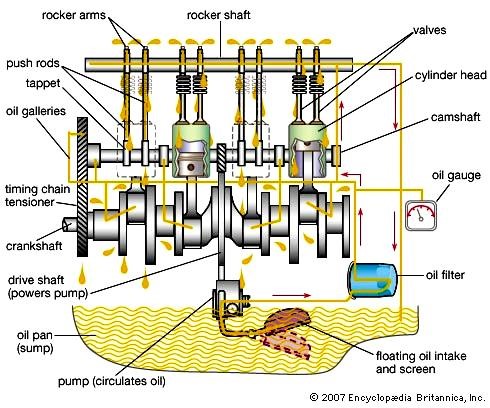
Notes:
lubrication system, n.–система смазки
film, n.–пленка
friction, n.–трение
pump, n.–насос
oil gauge, n. – масляной манометр
rocker shaft, n. – ось клапанного коромысла
crankshaft, n. – коленчатый вал
drive shaft, n. – ведущий вал
impurities, n. – грязь, примеси
camshaft, n.–распределительный вал, кулачковый вал
timing chain, n. – цепь механизма газораспределения
tensioner, n. – натяжное устройство
push rod, n. – толкатель;
tappet, n. – толкатель клапана, кулачок
rocker arm, n. – качающийся рычаг
III. Read the text “Electrical System” and say what it is used for.
Electrical System
Every vehicle needs electricity to provide current for lights and other electrical equipment and to supply the necessary power for the ignition system. The electrical system is equipment in a car which provides electricity to start the engine, ignite the fuel, operate the lights, windscreen wipers, heater and air conditioner.
One of the most important components of an electrical system is the battery. The electrical system starts and stops with the battery. While the vehicle is operating the electrical system is energized and recharged by the alternator that is powered by the engine. When troubleshooting an electrical problem start with the battery. By using a volt meter determine if the battery has enough voltage to operate the electrical system.
There are dozens of electrical components related to the electrical system, most include one or more of the following: alternator, battery, fuse, switch, relay, computer PCM, fusible link, wire, and electrical connectors. Each vehicle has several fuses that are necessary to safe guard electrical circuits.
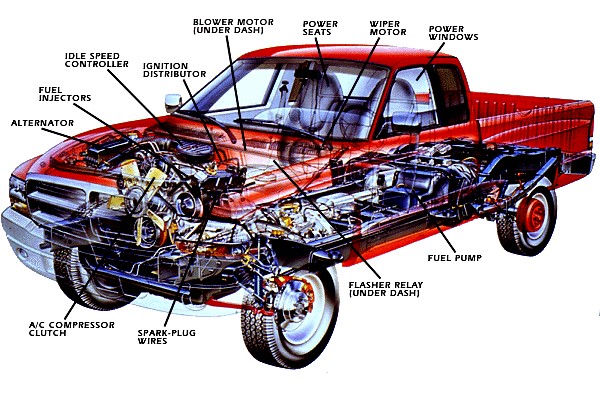
Notes:
fuse, n. – плавкий предохранитель
fusible link, n. – плавкое соединение
PCM (Pulse Code Modulation), n. – импульсно-кодовая модуляция сигнала
troubleshooting, n. – выявление неисправностей
power seat, n.–сиденье с электрическим приводом регулировки
blower motor, n.– моторвентилятора
wiper motor, n.–электродвигатель стеклоочистителя
power window, n.– окно с сервоприводом стекла
idle speed controller, n. – регулятор управления холостым ходом
flasher relay, n. – прерыватель указателей поворота и аварийной сигнализации
IV. Scan the text “Ignition System” to find answers to these questions.
- What does the ignition system depend on?
- Where is it located?
- What process is called combustion?
- What does the ignition system consist of?
Ignition System
The ignition system enables the engine to start and keep running. It depends on the type of engine and the fuel used. Petrol engines are typically ignited by a precisely timed spark, and diesel engines by compression heating.
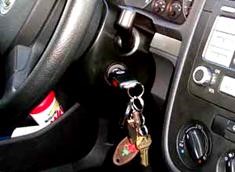
The ignition is located either on the side of the steering column or on the dashboard. It is a multifunction switch, into which you insert your key, in order to energize the electrical circuits and activate your starter motor.
The spark plugignites the fuel and air mixture in each cylinder. This process is called “combustion” and it takes place in the “combustion chamber”.
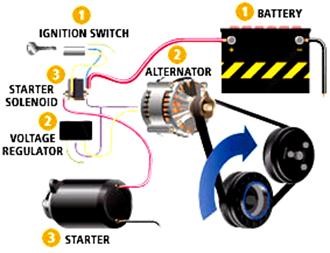
Electricity for the igniting process or ignition is supplied by an alternator and a battery. The current is then carried to a coil, then to a distributor and finally to the spark plugs.
The car’s starting system consists of two components: the electric starter motor and the starter solenoid. As you turn the ignition key to the start position, the starter solenoid gets activated and this energizes the starter motor. The starter motor spins the engine a few revolutions allowing the combustion process to begin and the car to start moving.
Notes:
ignition system, n. – система зажигания двигателя
ignite, v. – воспламенять
spark plug, n. – свеча зажигания
combustion chamber, n. – камера сгорания
alternator, n. – генератор переменного тока
current, n.–ток
coil, n. – катушка
distributor, n. – распределитель зажигания
spin, v.– крутить
V. Read the text and describe the cooling system operation.
Cooling system
The primary job of the cooling system is to cool the engine and to keep it from overheating. Another important job of the cooling system is to allow the engine to heat up as quickly as possible and then to keep the engine at a constant temperature because when the engine is cold its components wear out faster and the engine is less efficient and emits more pollution.
There are two types of cooling systems used in modern cars: air-cooled and liquid-cooled systems.
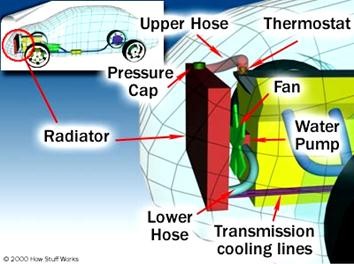
Most cars are equipped with liquid-cooled systems. The coolant flows around the engine and then passes through the radiator. Then it passes through the water pump and flows around the engine again. There are some stages of the cooling process. First, the liquid flows around the engine. The engine is cooled and the liquid is heated. The hot water enters the radiator through the upper (top) hose. Then it flows down through the radiator and here it is cooled by air. The air is pulled by a fan. This fan is turned by a belt which is driven by the engine. The cooled liquid leaves the radiator through the lower (bottom) hose. The coolant is pumped around the engine again.
Modern cars operate in a wide variety of temperatures. So the fluid used to cool the engine must have a very low freezing point and a high boiling point and hold a lot of heat. Water freezes at too high a temperature to be used in car engines. The coolant used in most cars is a mixture of water and ethylene glycol called antifreeze. The recommended ratio is fifty-fifty. In other words, one part of antifreeze and one part of water.
Notes:
overheating, n. – перегрев wear out, v. – изнашиваться
emit pollution, v. – выделять загрязнение
air-cooled, adj. – с воздушным охлаждением
liquid-cooled, adj. – с жидкостным охлаждением
coolant, n.– охлаждающая жидкость
water pump, n. – водяной насос flow around, v. – обтекать
liquid, n. – жидкость hose, n. – шланг
belt, n. – ремень fluid, n. – жидкость
freezing point, n. – точка замерзания
boiling point, n. – точка кипения
VI. Scan the text to find answers to these questions.
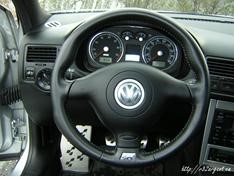
- What is a steering wheel used for?
- What kinds of steering systems are there?
- What is the hydraulic power steering?
- How does the electric power steering work?
Steering System
A steering wheel is a type of steering control in vehicles. The steering wheel is the part of the steering system that is manipulated by the driver; the rest of the steering system responds to the driver inputs. This can be through direct mechanical contact without or with the assistance of the Hydraulic Power Steering (HPS), or with the assistance of computer controlled motors, known as the Electric Power Steering (EPS).
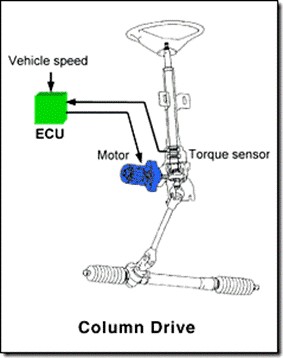
The steering wheel is located directly in front of the driver’s seat. Turning the steering wheel transmits force, which turns the wheels to determine the direction of travel.
Most vehicles today have power steering, which makes turning the wheel relatively easy. The hydraulic power steering (HPS) is a hydraulic system for reducing the steering effort on vehicles by using hydraulic pressure to assist in turning the wheels. It is intended to provide for easier driving direction control of the car while preserving "feedback", stability and unambiguity of the trajectory specified.
The hydraulic power steering uses high pressure fluids for assisting the steering movement. When the driver turns the steering wheel, it opens up the flow or pressurized fluid in such a way that helps to turns the wheels in the required direction.
The electric power steering works with the help of an electric motor and an electronic control unit (ECU) which has some sensors.
The motor runs on battery and will use electric power to assist the movement of steering when the driver turns the wheel.
Notes:
steering wheel, n. – рулевое колесо
assistance, n.– помощь
power steering, n. – рулевое управление с усилителем
reducing effort, n. – уменьшение усилия
feedback, n.– обратная связь
pressurized fluid, n. – жидкость или газ под давлением
electronic control unit, n. – электронный блок управления
VII. Read the text and say why the exhaust system is very important for a good performance of a car.
Exhaust System
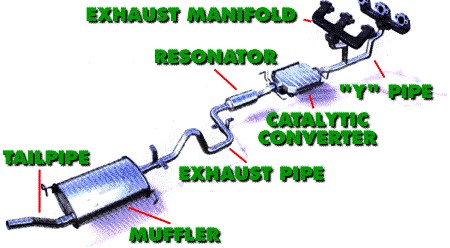
This is a diagram of the major components of an exhaust system in a car. Exhaust system components are designed for a specific engine. The pipe diameter, component length, catalytic converter size, muffler size, and exhaust manifold design are engineered to provide proper exhaust flow, silencing, and emission levels on a particular engine.
As a rule, the hotter a muffler runs the longer it lasts. Mufflers on vehicles with catalytic converters run hotter and last longer than those on older vehicles without converters. Mufflers located ahead of the rear axle last longer than those located after of the rear axle.
Mufflers rust from the inside out. Rust is caused by moisture in the exhaust. Moisture condenses in the muffler when the engine is shut off and the muffler starts to cool.
The longevity of muffler and pipes depends on what kind of steel the components are made of, how pipes are routed under the car, where the muffler is located, and whether or not the vehicle has a catalytic converter.
Original equipment pipes made of stainless steel (which are used from the converter forward on most cars and for the entire exhaust system on some) can last up to 10 years or more. Most aftermarket pipes, by comparison, are made of ordinary steel which is good for about three to five years of service. Aluminized and stainless pipes are better, but cost more.
Notes:
exhaust system, n. – система выпуска двигателя
catalytic converter, n. – каталитический дожигатель выхлопных газов
exhaust manifold, n. – коллектор выхлопной системы двигателя
silencing, n. – глушение
muffler, n. – глушитель
rust, v. – ржаветь
moisture, n. – влага
shut off, v. – выключать
stainless – коррозионно-стойкий
VIII. Scan the text to find answers to these questions.
- What types of brakes are in general use today?
- Where are they used?
- How do disc brakes operate?
- How drum brakes operate?
Braking System
Every car must have brakes to be slowed or stopped once it has been set in motion. Modern cars travel very fast, so good brakes are essential for safety.
Two kinds of brakes are in general use today: drum brakes and disk brakes. Disc brakes have more powerful stopping effect that’s why they are fitted to the bigger and faster cars. Most of cars combine the two and have disc brakes for the front wheels and drum brakes for the rear.
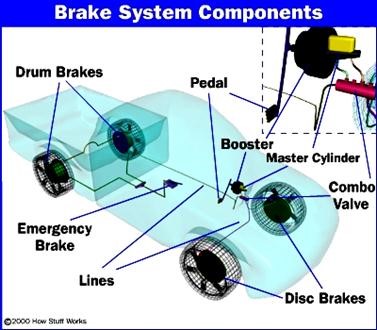
When the brake pedal is pushed a piston pushes the pad towards the brake disc which slows the wheel down. On the brake drum it is similar as the cylinder pushes the brake shoes towards the drum which also slows the wheel down.
Most discs today are fluid operated (hydraulic). When the driver presses the brake pedal it causes a piston to move inside a master cylinder. This forces the fluid along narrow pipes to each wheel where a small piston is pushed outward to operate the pads.
Notes:
braking system, n.–тормозная система
drum brake, n.–барабанный тормоз
disk brake, n. – дисковый тормоз
brake drum, n.–тормозной барабан
pad, n.–тормозная колодка
shoe, n. – тормозная колодка
fluid, n.–жидкость
master cylinder, n.–главный тормозной цилиндр
booster, n. – усилитель
Morozova О.N., Ilina I.Y.Тамбов2015